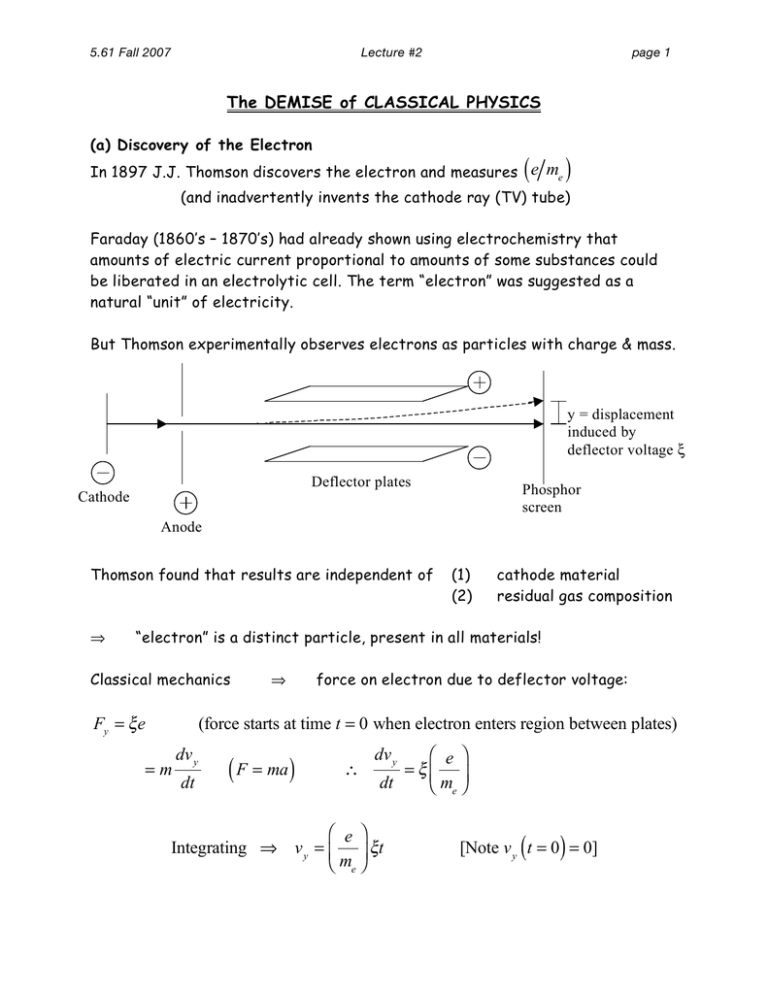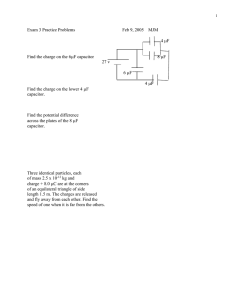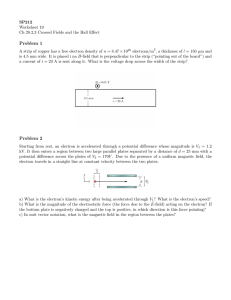( ) e m The DEMISE of CLASSICAL PHYSICS
advertisement

5.61 Fall 2007 Lecture #2 page 1 The DEMISE of CLASSICAL PHYSICS (a) Discovery of the Electron ( In 1897 J.J. Thomson discovers the electron and measures e me ) (and inadvertently invents the cathode ray (TV) tube) Faraday (1860’s – 1870’s) had already shown using electrochemistry that amounts of electric current proportional to amounts of some substances could be liberated in an electrolytic cell. The term “electron” was suggested as a natural “unit” of electricity. But Thomson experimentally observes electrons as particles with charge & mass. y = displacement induced by deflector voltage ξ Deflector plates Cathode Phosphor screen Anode Thomson found that results are independent of ⇒ (1) (2) cathode material residual gas composition “electron” is a distinct particle, present in all materials! Classical mechanics Fy = ξ e ⇒ force on electron due to deflector voltage: (force starts at time t = 0 when electron enters region between plates) =m dv y dt ( F = ma ) ∴ ⎛ e ⎞ = ξ⎜ ⎟ dt ⎝ me ⎠ dv y ⎛ e ⎞ Integrating ⇒ v y = ⎜ ⎟ ξt ⎝ me ⎠ ( ) [Note v y t = 0 = 0] 5.61 Fall 2007 Lecture #2 page 2 ⎛ e ⎞ ξt f dy Integrating again since v y = and y t = 0 = 0 ⇒ y = ⎜ ⎟ dt ⎝ me ⎠ 2 ( 2 ) t f = total time electron is between the plates (easily calculated) Set voltage ξ , calculate time t f , measure displacement y ⇒ ⎛ e ⎞ 11 ⎜ m ⎟ = 1x10 C/kg ⎝ e⎠ ⎛ e ⎞ = 1.758x1011 C/kg ⎟ ⎝ me ⎠ Modern day value is ⎜ (b) 1909 Milliken oil drop experiment determines e, me separately mist of micron-size oil droplets in air Fg Gravitational force downward: Fg = − Mg M = mass of droplet, g = gravitational constant Ff Frictional force upward due to air: F f = 6π rηv r = radius of droplet, η = air viscosity, v = droplet velocity Since F f ∝ v , terminal velocity vt is reached when forces balance 6π rηvt = Mg ⇒ get droplet mass M = 6π rηvt g ( ) Now use x-rays or γ-rays to add some charge ne to the droplets Voltage ξ across plates exerts Coulomb force Fc = ξ ne on the charged droplet x-rays n- Fc Fg Ff n- n- n- 5.61 Fall 2007 Lecture #2 v = 0 ⇒ F f = 0, Adjust voltage until drop stops falling: ξ ne = Mg page 3 Fc = Fg Determine ne = Mg ξ Mulliken did this for lots of droplets i = 1,2,3,... ( ) () They all had different charges ni e but all integer multiples of charge e Determined elementary charge as e = 1.59x10 (very close to today’s value e = 1.602x10 ( Combining values for e me ) and ( e) ⇒ me = 9.11x10 Hydrogen mass was known: mH = 1.66x10 −27 −31 −19 −19 C C) kg kg ⇒ electron is subatomic!! (c) Where are the electrons? What’s the structure of the atom? Angstrom (10-10 m) atomic size scale already inferred from gas kinetics First “jellium” model didn’t last long (jelly) n+ e− Rutherford backscattering experiment He 2+ He (no electrons) 2% scatter back ⇒ (1) (2) Au foil 2+ 98% undeflected He2+ nucleus very small, << 10 -10 m (Rutherford estimated 10-14 m) Au atoms are mostly empty! 5.61 Fall 2007 Lecture #2 page 4 Rutherford planetary model: classical mechanical model of atomic structure Coulomb attraction plays the role of gravity centripetal force r +Z v e− Coulomb force for stable orbit Fc = me v 2 r Ze2 FC = 4πε 0 r 2 me v 2 r Ze2 = 4πε 0 r 2 Ze2 ⇒ r= 4πε 0 me v 2 This is stable compared to separated electron & nucleus ⎛ 1 Ze2 ⎞ 1 Ze2 2 E = K.E. + P.E. = me v + ⎜ − <0 ⎟ =− 2 2 4πε 0 r ⎝ 4πε 0 r ⎠ BUT model not consistent with classical electrodynamics: Accelerating charge emits radiation! (centripetal acceleration = v2/r) And since light has energy, E must be getting more negative with time ⇒ r must be getting smaller with time! ⇒ Electron spirals into nucleus in ~ 10-10 s ! Also, as r decreases, v should increase Frequency ν of emitted light = frequency of rotation ν (Hz = cycles/s) = v (m/s) 2π r (m/cycle) circumference of orbit ⇒ atom should emit light at all frequencies – that is it should produce a continuous spectrum 5.61 Fall 2007 Lecture #2 page 5 BUT emission from atoms was known to be discrete, not continuous! For H: n1 = 3 n1 = 2 n2 = 3 4 5 6… 10,000 30,000 n1 = 1 n2 = 2 50,000 3 4… 100,000 (cm-1) For the H atom, Rydberg showed that the spectrum was consistent with the simple formula: ⎛ 1 1 ⎞ ν (cm -1 ) = R ⎜ 2 − 2 ⎟ ⎝ n1 n2 ⎠ with n1 = 1, 2, 3, ... and n2 = n1 + 1, n1 + 2, n1 + 3, ... R = 1.097x105 cm -1 (Rydberg constant) n1 = 1 Lyman series n1 = 2 Balmer series n1 = 3 Paschen series visible & UV lines well known Summary: (1) (2) (3) Rutherford’s model of the atom Is not stable relative to collapse of electron into nucleus Does not yield discrete emission lines, Does not explain the Rydberg formula



